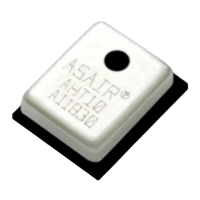2.2 Storage conditions and operating instructions
Humidity sensitivity level ( MSL ) is 1 , based on
IPC/JEDEC J-STD-020 standard. Therefore, it is
recommended to use it within one year after
shipment.
Humidity sensors are not ordinary electronic
components and require careful protection. This
must be taken seriously by users. Prolonged exposure
to high concentrations of chemical vapor will cause
the sensor reading to drift. It is recommended to
store the sensors ESD original package comprises a
sealed bag, and meet the following conditions:
Temperature range 1 0 ℃ -50 ℃ (0-85 deg.] C for a
limited time); humidity of 20-60% RH (no ESD
Package Sensor). For sensors that have been removed
from the original packaging, we recommend storing
them in the inner metal.
Anti-static bag made of PET/AL/CPE material.
Sensors should be avoided during production and
transportation
High concentrations of chemical solvents and
prolonged exposure.
Avoid contact with volatile glue, tape, stickers or
volatile packaging materials. Such as foam, foam and
so on. The production area should be well ventilated.
2.3 recovery processing
As described above, if the sensor is exposed to
extreme conditions or chemical vapors,
readings generated drift. It can be restored to the
calibration state by the following processing.
Drying: maintained at 80-85 ° C and <5% RHhumidity
for 10 hours;
Rehydration: 12 hours at 20-30 ° C and >75% RH
humidity.
2.4 temperature effects
The relative humidity of a gas depends to a large
extent on temperature. Therefore, when measuring
humidity, it should be ensured that all sensors
measuring the same humidity work at the same
temperature. When testing, ensure that the sensor
under test and the reference sensor are at the same
temperature and then compare the humidity readings.
If the sensor is on the same printed circuit board as the
heat-generating electronic components, measures
should be taken to minimize the effects of heat
transfer when designing the circuit.
In addition, when the measurement frequency is too high,
the sensor's own temperature will rise and affect the
measurement accuracy. If it is to ensure that its own
temperature rise is less than 0.1 ° C , the activation time
of AHT10 should not exceed the measurement
time. 10% - recommended every 2 seconds
measurement data once.
2.5 Materials for sealing and packaging
Many materials absorb moisture and act as a buffer, which
increases response time and hysteresis. Therefore, the
material around the sensor should be carefully selected. The
recommended materials are: metal, LCP, POM (Delrin),
PTFE (Teflon), PE, PEEK , PP, PB, PPS,
PSU, PVDF, PVF .
For sealing and
gluing (the conservative recommendation): recommended p
ackage, or an electronic component using a silicone
resinfilled epoxy. The gases released by these materials may
also contaminate AHT10 (see2.2). Therefore, the sensor
should be assembled last and placed in a well-ventilated
area or dried in an environment > 50 ° C for 24 hours to
allow the release of contaminated gases prior to packaging.
2.6 wiring rules and signal integrity
If the SCL and SDA signal lines are parallel and very close to
each other, it may cause signal crosstalk and communication
failure. The solution is to place VDD and / or GND between

